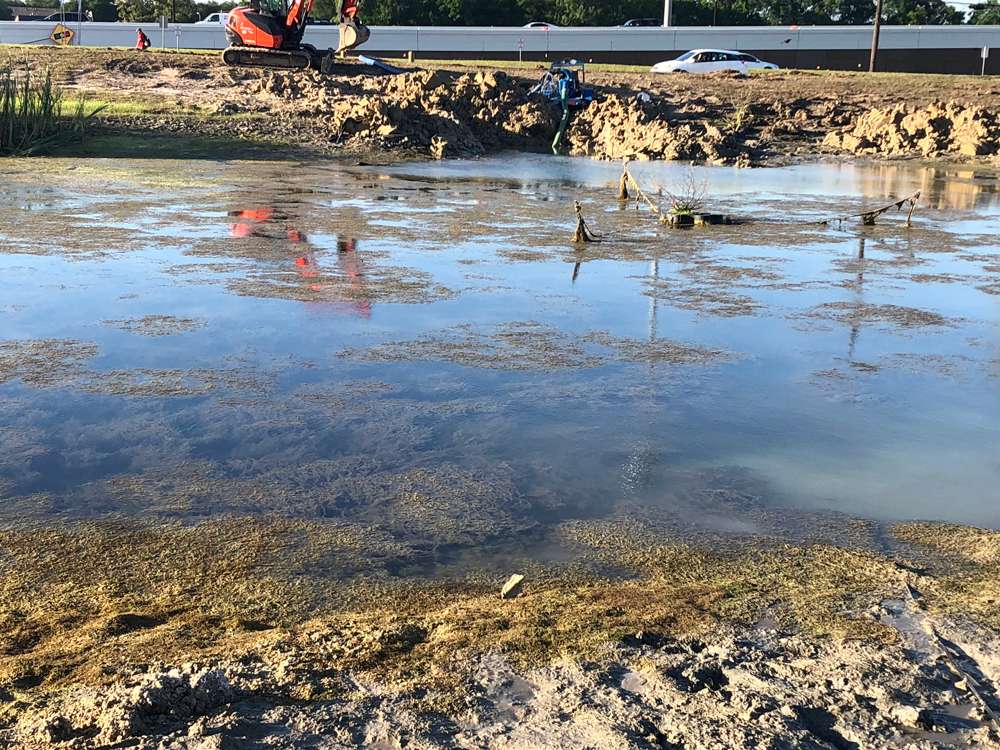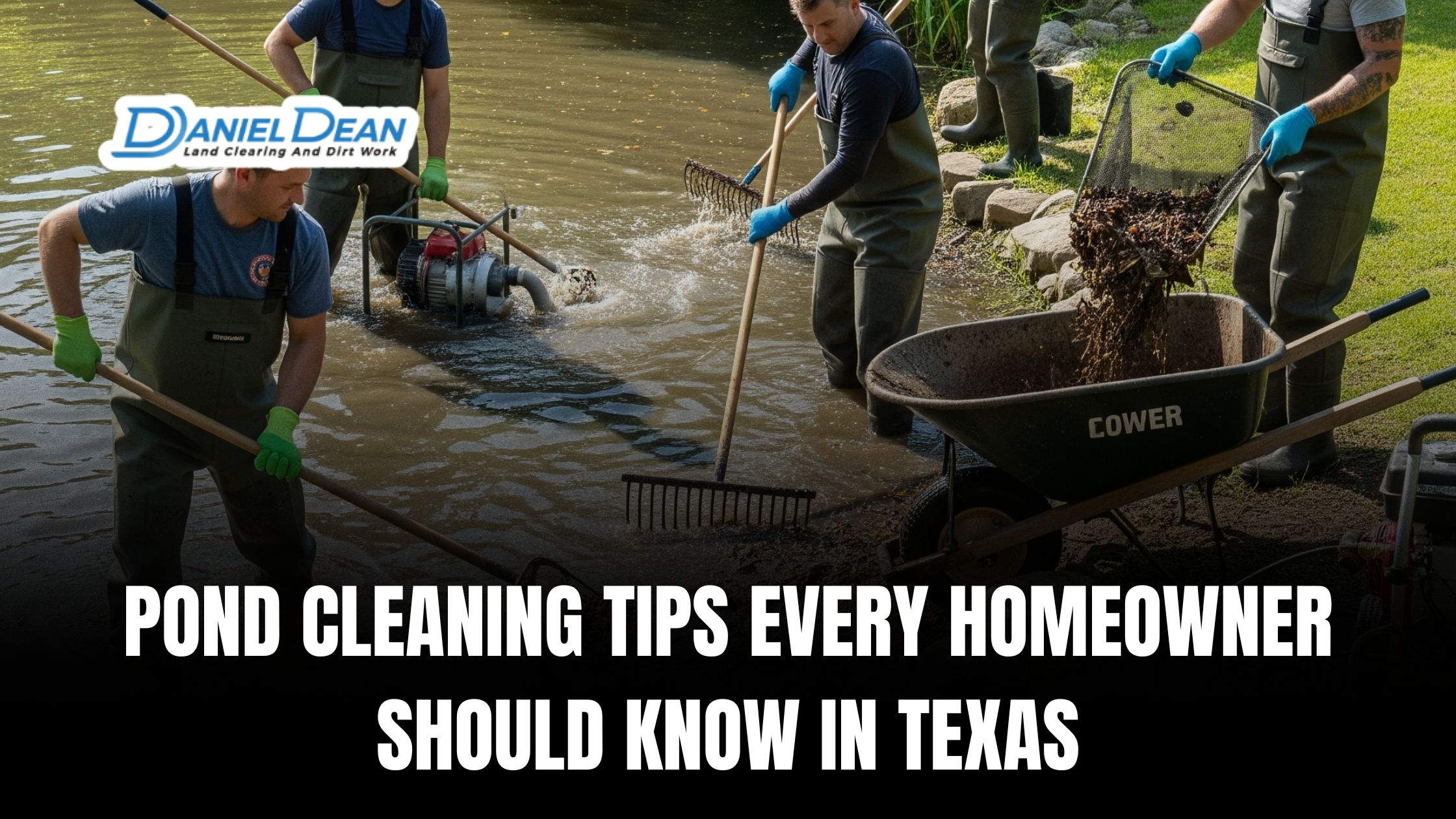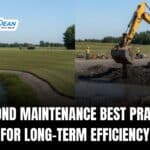Pond cleaning is one of the most important tasks for homeowners who want to keep their property in top shape. In Texas, a well-maintained pond not only provides water for livestock and supports fish and wildlife but also adds real value to the land. Research shows that a pond can increase property worth by about $4,500 per surface acre, while water features may raise bare land values by up to 42%. Without regular care, though, dirty pond water can quickly turn from a beautiful feature into a costly problem.
In this blog post, you will discover practical pond cleaning tips every Texas homeowner should know. You will learn how to prevent dirty pond water from taking over, the simple steps you can apply year-round, and when it is best to call in experts. We will also explore how a Texas contractor search can connect you with professionals who know how to restore clarity and health to your pond.
Understanding Why Pond Cleaning Matters
Pond cleaning is not only about keeping the water clear but also about protecting the overall health of your property. When debris, algae, and sediment accumulate, they create dirty pond water that throws off the natural balance. This buildup reduces oxygen levels, harms fish populations, and can trigger unpleasant smells. For Texas homeowners, regular cleaning is essential to preserve both the function and appearance of ponds.
- Water quality protection: Without pond cleaning, nutrient overloads lead to algae blooms that cloud the water and reduce oxygen. This makes the pond unsafe for fish, livestock, and other wildlife that depend on it.
- Pest control: Stagnant dirty pond water creates the perfect breeding ground for mosquitoes. Keeping water moving and clean reduces the spread of pests and lowers health risks around the property.
- Property value maintenance: A neglected pond is unattractive and can decrease land value significantly. Regular pond cleaning helps maintain or even increase value by presenting a clean, healthy water feature to potential buyers.
- Cost prevention: Allowing problems to build up often leads to expensive remediation, such as dredging or chemical treatments. Routine cleaning reduces the chance of needing large-scale fixes later.
For anyone managing land in Texas, ignoring pond health is not a risk worth taking. A clean pond adds to the beauty of your property, supports wildlife, and protects your investment. And when problems become too large to handle, a quick Texas contractor search can help you find experts who know how to restore balance and eliminate dirty pond water before it becomes a bigger issue.
Simple Steps to Prevent Dirty Pond Water
Routine pond cleaning is the foundation of a healthy water system. By following these five numbered steps, Texas homeowners can keep their ponds clear, avoid dirty pond water, and reduce the need for costly repairs later.
1. Remove Debris Regularly
Organic debris is the leading cause of poor water quality in ponds. When leaves, grass clippings, or branches sink, they decay and release phosphorus and nitrogen into the water. These nutrients accelerate algae growth, which clouds the pond and reduces oxygen.
Over time, the buildup also increases sediment at the bottom, making future cleanings harder. To prevent this, skim the pond at least once a week during peak seasons. For properties surrounded by trees, add floating nets in autumn to block heavy leaf fall. Regular debris removal keeps water clear, reduces odors, and lowers the workload of future pond cleaning sessions.
Quick tip for Texas homeowners:
- Skim weekly in spring and summer when plant growth is high.
- Increase frequency to every 2–3 days in autumn when leaves drop heavily.
2. Balance Aquatic Plants
Aquatic plants act as natural filters, absorbing excess nutrients that fuel algae blooms. They also provide shade that lowers water temperature, slowing algae reproduction.
In Texas, water lilies and lotus are excellent surface plants, while submerged species like anacharis work well for oxygenation. However, too much plant coverage creates the opposite problem by blocking sunlight completely and choking oxygen flow. Experts recommend covering 50–60% of the pond surface with vegetation for best balance.
| Plant Type | Benefit | Caution |
| Floating plants | Provide shade, reduce algae growth | Can spread quickly, monitor |
| Submerged plants | Add oxygen, filter excess nutrients | Overgrowth may lower circulation |
| Marginal plants | Prevent erosion, improve filtration | Keep trimmed to avoid takeover |
Balanced planting creates a self-regulating system that supports pond cleaning efforts and keeps dirty pond water under control.
3. Monitor Fish Populations
Fish add vibrancy to a pond, but too many can overwhelm the system with waste. Ammonia from fish waste converts into nitrates, which fuel algae blooms and create cloudy, dirty pond water. A safe stocking level is no more than 1 inch of fish per gallon of water for small ponds. For larger ponds in Texas, follow the guideline of 100–300 fish per surface acre, depending on species and size.
Warning signs of overcrowding:
- Persistent cloudy water even after debris removal
- Fish gasping at the surface
- Algae blooms spreading quickly
If you’re unsure about your pond’s capacity, a Texas contractor search can help you connect with experts who measure volume and recommend proper stocking levels. Balanced populations protect water quality, improve fish health, and make ongoing pond cleaning more efficient.
4. Check Water Circulation
Water circulation is essential to keeping oxygen levels balanced and preventing stagnation. Without it, dirty pond water develops, foul odors increase, and mosquito populations grow. Pumps and aerators move water continuously, ensuring oxygen is distributed from top to bottom. This is especially important in Texas, where high summer heat can lower dissolved oxygen by 20–30%. Aeration also stops thermal layering, which can trap fish in low-oxygen zones.
Best practices for circulation systems:
- Choose pumps that circulate the full pond volume every 2–3 hours.
- Place aerators at the deepest point to push oxygen upward.
- Inspect equipment monthly to ensure proper operation.
With circulation in place, ponds stay healthier, and the overall pond cleaning workload becomes lighter and more effective.
5. Schedule Seasonal Cleanings
Routine maintenance handles day-to-day issues, but seasonal pond cleaning resets the entire system. In Texas, spring cleanings prepare the pond after winter dormancy, while late summer cleanings counteract stress from heat and rainfall. During these times, homeowners should:
- Remove 20–30% of pond water and replace it with fresh water.
- Vacuum sediment at the bottom to control nutrient buildup.
- Cut back vegetation to the recommended 50–60% coverage.
- Inspect pumps, aerators, and liners before the next season.
For larger ponds, professional help may be necessary to handle sediment removal or structural work. Using a Texas contractor search ensures you find specialists with the right equipment and knowledge. Seasonal cleaning prevents dirty pond water from becoming a recurring challenge and extends the life of your pond as a valuable feature. If you are considering improvements beyond cleaning, you may also find it helpful to review site preparation common mistakes to avoid costly errors in future projects.
When to Call in Professional Help

Even with consistent pond cleaning, there are times when the problem is too large for homeowners to manage on their own. Dirty pond water that lingers despite regular skimming, algae control, and plant management can indicate deeper issues such as sediment buildup, poor water chemistry, or equipment failure. At this point, professional intervention saves time, prevents further damage, and ensures the pond remains an asset rather than a liability.
Situations that require professional pond cleaning services:
- Persistent algae blooms: When algae spreads rapidly across more than 30–40% of the pond surface, it signals an imbalance that DIY treatments rarely fix.
- Thick sediment layers: If sludge at the bottom exceeds 6 inches, it reduces water depth, lowers oxygen, and fuels recurring dirty pond water.
- Equipment breakdowns: Malfunctioning pumps or aerators that fail to circulate water can cause stagnation, especially during hot Texas summers.
- Unpleasant odors or fish kills: Strong sulfur-like smells or sudden fish deaths point to critical oxygen depletion that requires immediate expert care.
When these warning signs show up, turning to a Texas contractor search is a smart step, but choosing a trusted local expert like Daniel Dean makes the process even easier. With years of experience handling pond cleaning and land management in Texas, Daniel Dean provides the right equipment and knowledge to restore your pond to a healthy balance.
Professional services not only clear away dirty pond water but also deliver long-term solutions that stop the same issues from returning. To understand why hiring an expert matters more than taking on the job alone, take a look at this guide on why land clearing is best left to professionals.
FAQs
What’s the best way to clean a pond?
The most effective method combines manual debris removal, proper filtration, and scheduled water changes. Skimming leaves, removing algae buildup, and vacuuming the pond bottom help maintain clarity. For deeper or larger ponds, professional cleaning ensures thorough sediment removal without damaging the ecosystem.
What is the best time of year to clean out a pond?
In Texas, the ideal time for pond cleaning is early spring before temperatures rise above 75% of summer highs. This timing allows you to reset the water and remove accumulated debris before algae growth peaks. A smaller maintenance cycle in autumn also helps reduce leaf buildup going into winter.
How to remove dirty water from a pond?
Dirty pond water can be removed using a pond pump or siphon system to drain sections of the water. Replacing no more than 30% at a time prevents shock to fish and plants. For ponds with heavy sediment or long-term neglect, professional contractors use dredging and vacuuming equipment to restore water quality efficiently.
Final Thoughts on Pond Cleaning Tips Every Homeowner Should Know in Texas
Keeping your pond clean is about more than appearance. It protects water quality, supports fish and wildlife, prevents pests, and even helps maintain property value. By removing debris, balancing plant life, monitoring fish populations, ensuring circulation, and scheduling seasonal cleanings, you can stop dirty pond water from becoming a long-term issue. Still, some situations require more than routine care. When algae, sediment, or equipment challenges grow beyond DIY fixes, it is time to bring in expert help.
Daniel Dean has the tools and experience to handle pond cleaning and land management projects across Texas. Whether you need routine maintenance or large-scale solutions, our team is ready to help protect your pond and your property investment. Contact us today with your questions or to request a consultation about pond cleaning, land clearing, or other services designed to keep your land in its best shape.






